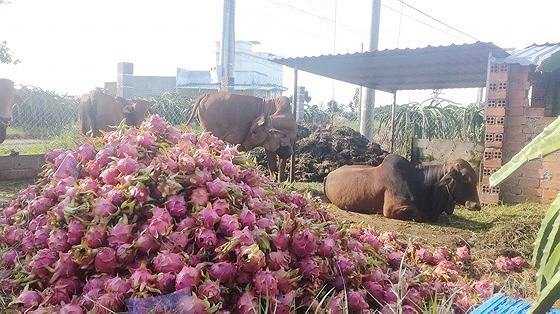
In Binh Thuan province, the largest farming area in the country, tens of tons of unsold dragon fruit have been piled along streets and riverbanks.
Ms. Nguyen Thi Ai, owner of thousands of dragon plants in Ham Thuan Nam district, said that she had directly contacted many traders to offer the fruit for sale but they all shook their heads.
Trying to rescuing the situation, Ms. Le My carried two baskets of the fruit to a buying spot in Ham Thuan Bac district but traders refused to buy. After much entreating by her, they agreed to buy at the dirt cheap price of VND500 a kilogram because she is a frequent supplier.
Holding VND70,000 in her hands, Ms. My said that she had three unsold tons of dragon fruits at home. Traders have stopped buying at orchards, farmers themselves must harvest and transport fruits to buying spots for sale at very low price.
Trader Tran Quang Thanh in Ham Thuan Nam district said that he had tens of tons of unsalable dragon fruits so he did not dare to buy more. The province has been reported to have about 10,000 hectares of ripen dragon fruits and 100,000 tons unsalable since early October.
The Mekong Delta provinces of Tien Giang and Long An have fallen in the same situation. Red fresh dragon fruit fetched up to VND20,000 a kilogram last month when traders jostled to buy. Now, the price drops to VND2,000-5,000 a kilogram now but they refuse purchase.
Many households in the two provinces have been heavily damaged. Some traders have accepted to leave their deposits instead of buying according to agreements with farmers to reduce loss.
Mr. Chin Phuoc from Chau Thanh district, Long An said that a couple of weeks ago, trader made a deposit of VND20 million to buy his 4,000 square meters of red fresh dragon fruit at the price of VND20,000 a kilogram. Because of the price fall, they have left the deposit and stopped buying.
Chinese market frozen
Traders in the Mekong Delta said that “bumper crop, price fall” refrain has recurred three times since 2015, falling in 2015, 2016 and 2018.
An export company in Long An said that large harvest output has raised difficulties for storage and transport system.
Dragon Fruit Association in Binh Thuan province says that the price has hit bottom rock level his year. Not only traders but also businesses have slowed or stopped purchase because Chinese market has been frozen.
Mr. Pham Huu Thu, office chief of Binh Thuan province Department of Agriculture and Rural Development, said that one of the main reason for the price drop is oversupply. The weather was dry in July. So when it was rainy, many farmers have rushed to plant for sale in September and October.
Peak harvest time in Vietnam fell nearly at the same time with long National Day in China so trading has been stagnant and goods has been congested at border gates.
In addition, brown spot disease has seriously affected the fruit quality and value, he added.
Despite information that dragon fruit has been unsold because Chinese traders have stopped buying, Ms. Be Thi Thu Hien, deputy head of Plant Quarantine Agency in region 7 covering Cao Bang, Lang Son and Quang Ninh provinces, said that dragon fruit export from Vietnam to China through Tan Thanh border gate had been normal without any congestion.
About 100-140 trucks transport the fruit from the southern region to the border gate for export to China a day on average, she added. Price has reduced sometimes when fruit volume transported north is large.
The Plant Protection Agency said that Vietnamese businesses now export about 13,000 tons of high quality dragon fruit a day on average.
Recently, Asian and African Market Department under the Ministry of Industry and Trade has warned farmers of oversupply and consumption difficulty, saying that China has expanded its dragon fruit farming area and harvest time has been nearly at the same time in the two countries, from May to November.
Data from the agency show that dragon fruit area in China has totaled 35,555 hectares, equivalent to that in Vietnam now.
Some provinces in China such as Guangxi and Hainan have put dragon fruit to the list of major fruits for development in their thirteenth five year plans. Hence farming area and output are expected to continue increasing in upcoming years.
























